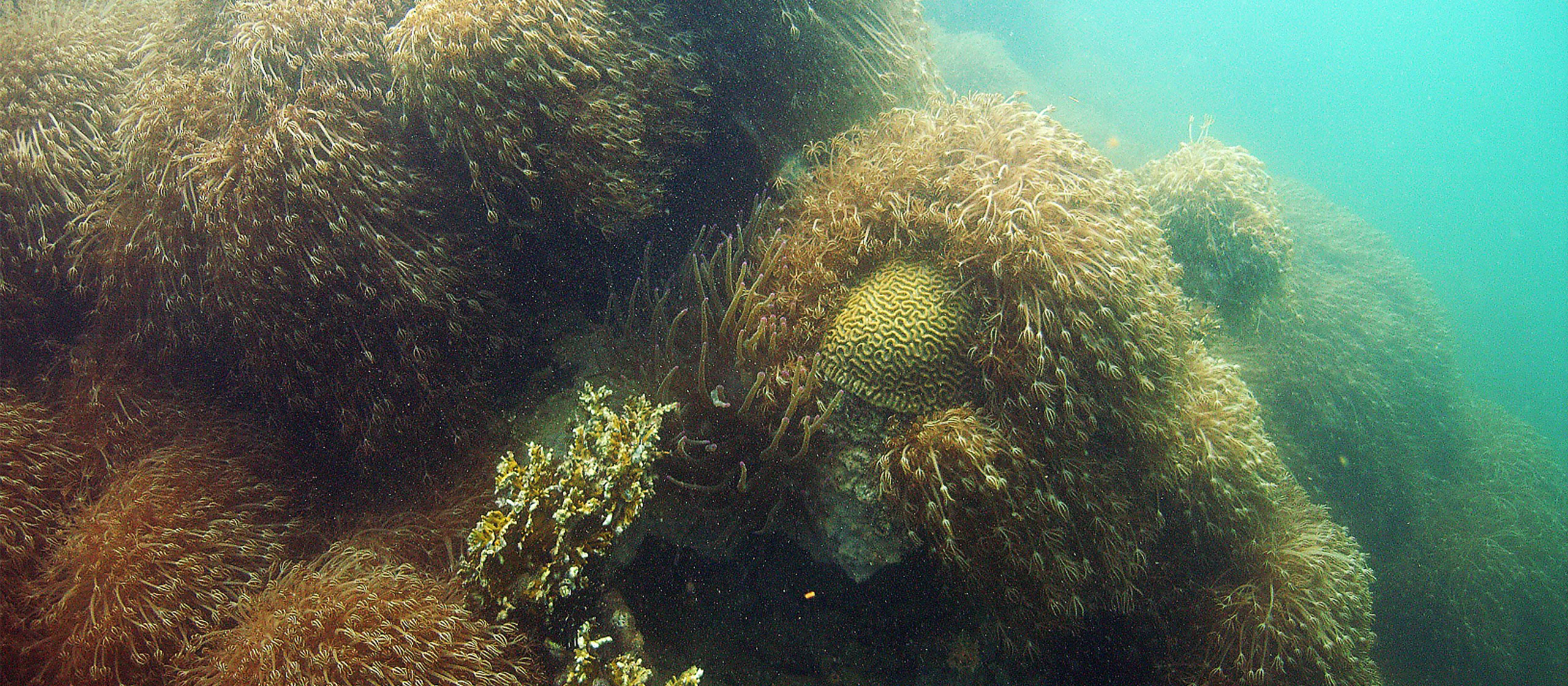Invaders: What We Know and What We Don’t Know
It’s like something out of science fiction, alien species are invaders—plants and animals that are found in places where they do not belong. If you’re thinking lionfish, you’d be right, but for this story, let me bring your attention to an exotic soft coral that has invaded, colonized, and rapidly transformed the coast of Venezuela in the Caribbean Sea, leaving wide-spread destruction in its path.
Investigators and scientists know that all living organisms will fight for an inch of territory, and that the transformation of the environment by animals and plants is not new. Mostly aided by massive globalization, these non-indigenous animals or plants easily and innocently find virgin territory where they can settle, reproduce, and then thrive. Let’s follow a story that tells of a case when a human deliberately introduced a new organism.
In this story, Juan Pedro Ruiz-Allais, a biologist, was diving along the Venezuelan coast when a new, shiny coral aroused his suspicion. The research study he did was published years after that first contact and, by then, the effects of the invader had become an ecological disaster.
Professor James Carlton, a marine ecologist and evolutionary biogeographer, describes this phenomenon thus: “With the arrival of every new species, it is very much like Russian Roulette. We spin a new species into the environment and the potential for catastrophic impact to society, to the economy, and to the environment is always there.”
Invader species are part of the evolutionary process; nonetheless, in an extremely slow progression and discovered hundreds, thousands, or even millions of years later through fossil records. Paleontologists map species geographically within a context; when a species expands their range during their lifetime or in relation to their ancestral species, then fossilists consider this species as an invader1.
The extremely fast progression of globalization has created a new problem. When humans introduce a species into a new ecosystem, it will probably succeed over the native species. The reasons for this will be explained later.
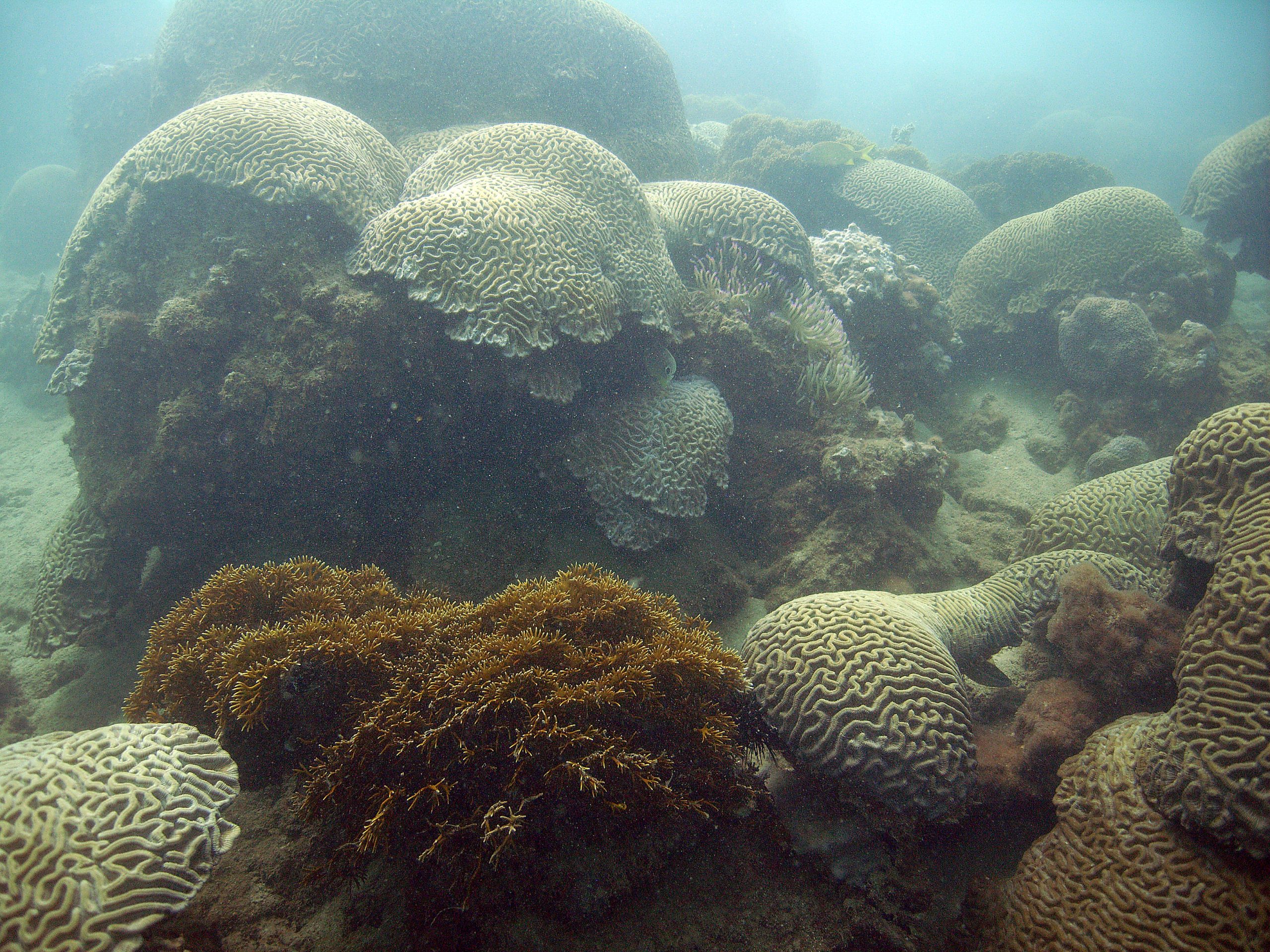
Status of the Coral reef at the beginning, when the alien species was identified, year 2007
Is a Story Useful?
Even though Juan Pedro had identified this soft coral as Xenia elongate, coral taxonomy is a complicated procedure and, ultimately, taxonomists created a new genus—Unomia stolonifera—for his find. Reclassification aids in differentiating this particular coral from a more typical Xenia strain and, for scientists, knowing a species2 classification is important in order to compare behaviors in different environments, and particularly in their native ecosystems.
Ironically, Unomia is a soft coral that aquarists widely use—not only for its beauty, but also for its exponential growth rate—which can match a few types of algae. Also, to the environment’s detriment, these corals are resilient.
Unomia are soft corals (octocorals3) native of the Indo- Pacific region, so how was this coral found on the Venezuelan northeastern coast in the Southeastern Caribbean Sea? The answer is the terrain of a story that begins with an aquarist entrepreneur who decided to grow and commercialize a coral species for decorating aquariums. He interfered with this wild area without knowing how much his actions would affect the ecosystem. Accident, ignorance, willfulness, or greed? History will decide.
There are laws prohibiting travel with wildlife, but this coral, even broken into pieces, will grow. Interestingly, the US Department of Agriculture advises that before entering the US and after having made contact with animals or livestock, travelers should launder all clothing worn where the contact took place and remove any dirt or debris from their shoes, equipment, or other articles before packing. This advice applies to divers as well. As professor Carlton explained, if a broken piece of soft coral is inadvertently attached to a diver’s suit or gear, and the diver visits other areas, the possibility exists that it will be loosened, deposited, and will grow and reproduce. Therefore, thoroughly washing dive equipment is not only for maintaining the gear, but also for protecting the environment. As divers, we must be careful to understand how fragile the underwater ecosystem is and take all precautions necessary to keep it undisturbed.
With the introduction of this coral, the damage to the ecosystem has already been done, no matter how it happened. What remains is that scientists study the scope of the damage, how fast it is spreading and what, if anything, can be done to control it. Even more importantly, what can be done to prevent these types of events? Understanding how it happened is often useful.
Quantifying the damage of Unomia is tracked along the coast and covers kilometers. Within these sites, Unomia was dominant over all the native species (stony corals, hydrocorals, and other indigenous anthozoans) surpassing all other corals combined. Also, the Unomia colonies are overgrowing seagrass where it is present. Scientists documented that these corals are spreading by adhering to bits of detached floating seagrass. This mechanism helped the coral to spread across a wide range of areas in less than ten years.
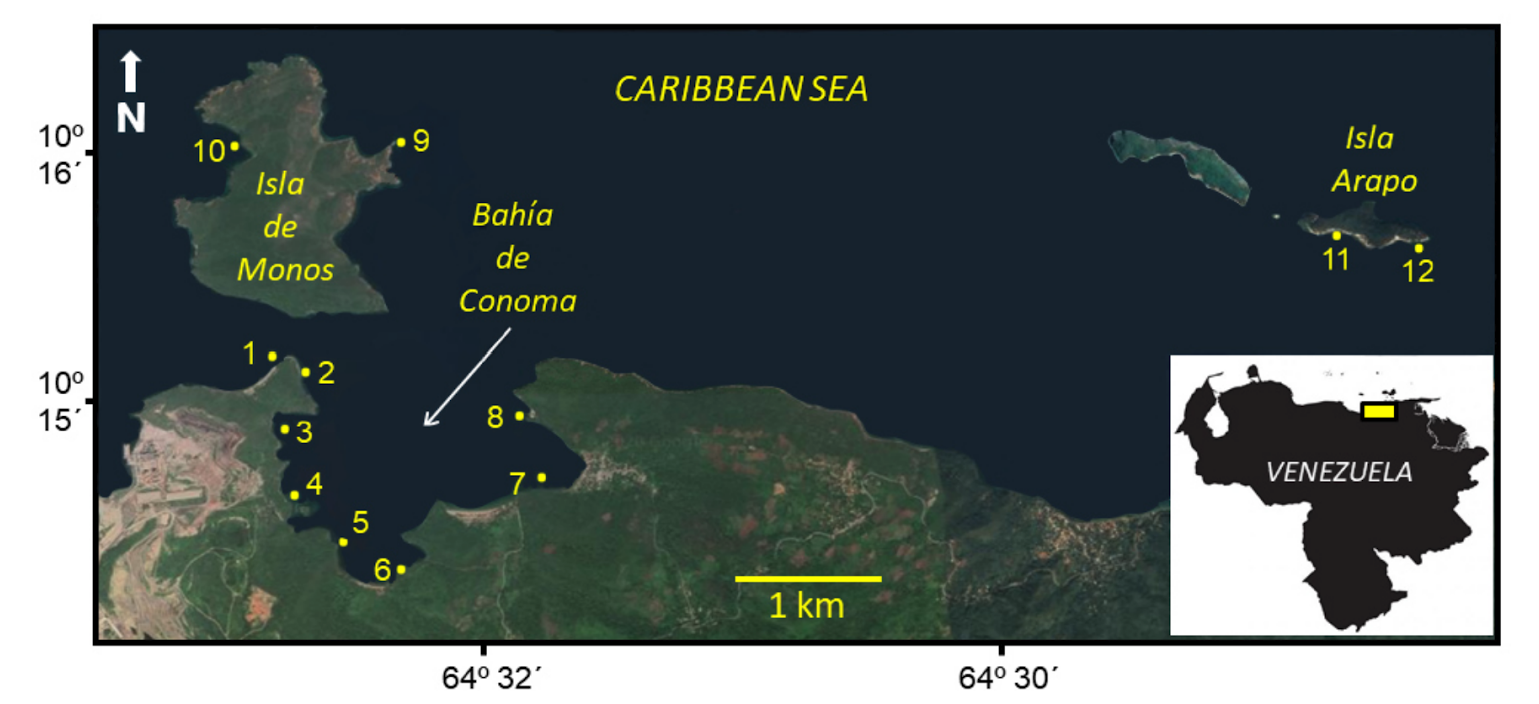
Location of the study sites published by Juan Pedro Ruiz-Allais, Yehuda Benayahu and Oscar Miguel Lasso-Alcalá along the northeastern coast of Venezuela, Southeastern Caribbean Sea: Bahía de Conoma (BC: sites 1-8), Isla de Monos (IM: sites 9, 10) and Isla Arapo (IA: sites 11, 12). Source: Modified from Google Earth 2020 base map. SIO, NOAA, NGA, GEBCO data. Image Landsat / Copernicus.
This means that this coral is capable of colonizing hard reefs and soft substrates. The decline in the variety of coral species and seaweed has consequences in the reef. These consequences are the vanishing of benthic species, fishes, crustacean and other organisms as the reef serves as a nursery ground for juvenile and larvae, food sources, refuge sites and breathing ground of all the organisms that interact within this ecosystem.
This will result in vast economic loss4, it will affect the direct value, for example, of fishing. It also affects the inherent value (biodiversity), for example, the pharmaceutical industry. But not only that, the photosynthetic capabilities of the reef are being reduced.
Is biocontrol an alternative to manage this situation?
Biocontrol is an intervention that humans perform to control an invasive species. Normally scientists introduce another organism which could be its natural predator. In the case of the Unomia, scientists introduced another organism into the environment, or it could be an endogenous organism that competes with the invader. In any case, scientists try to sustain the population that competes with the invader up until the situation is under control. Sometimes, more than one species is used as biocontrol.
Ecologists have tried biocontrol exercises inland with some success; nonetheless, in the sea another set of variables exists including a lack of boundaries, as well as sea currents and waves, making it nearly impossible to apply biocontrol in the ocean.
Another exercise that ecologists have tried is to use volunteers to eradicate the pest or invasive species. For example, encouraging divers to hunt the invasive Lionfish in the Caribbean. This type of control would be extremely difficult for an untrained eye and could result in the removal of the wrong species. In such an enterprise, the volunteer must be not only scientifically qualified, but also a trained diver, which made this effort not economically feasible.
Eradication is nearly impossible in the ocean with these types of corals because of its reproduction mechanism. Experimenting with farming native corals was considered, but this required both financing and an educated volunteer as was mentioned before.
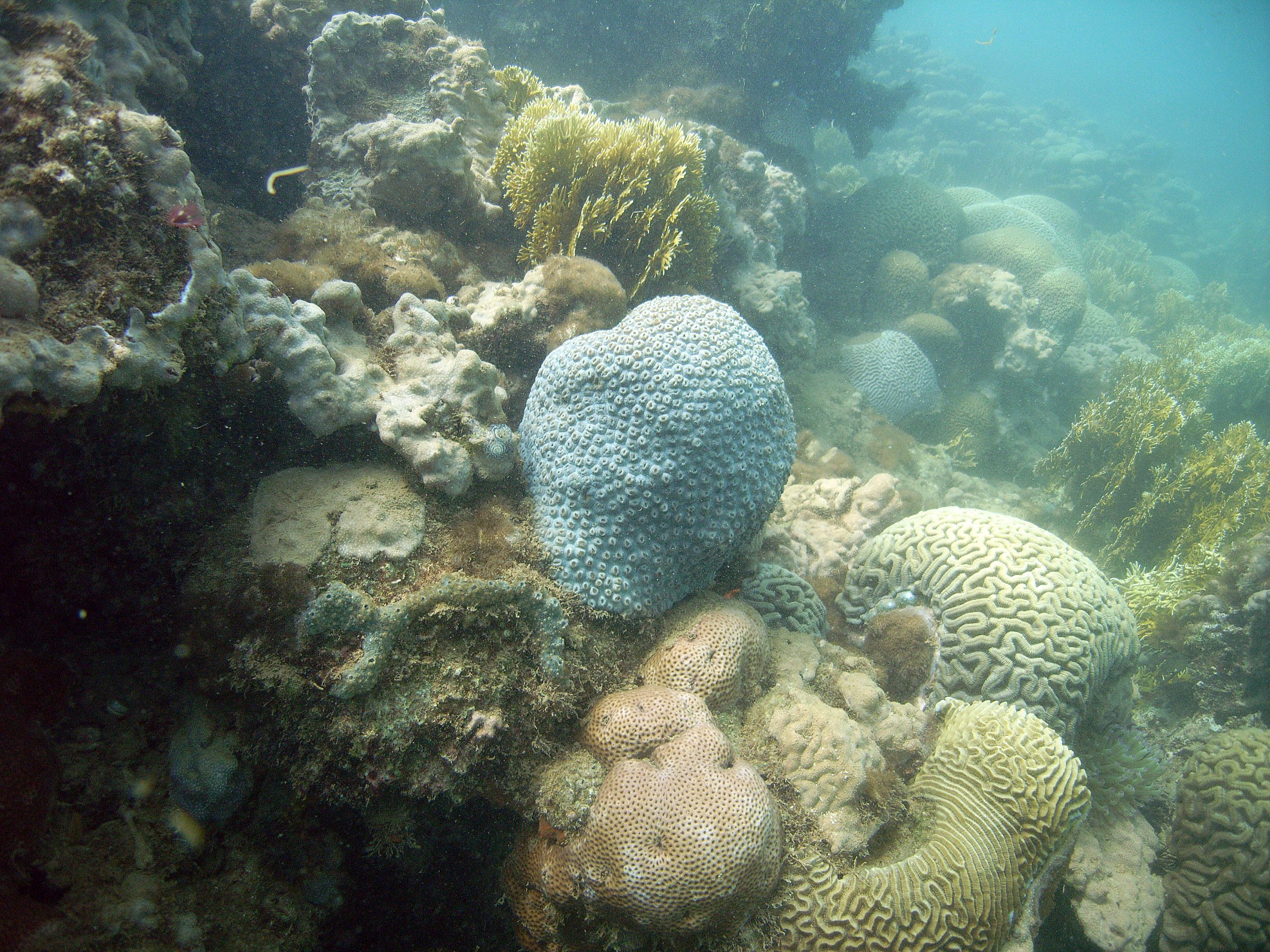
Status of the Coral reef at the beginning, when the alien species was identified, year 2007
Repeating patterns
In reviewing three unique cases, by no means the most important ones, we see that marine and coastal ecosystems have been subjected to multiple stressors, including warming oceans. Therefore, recognizing harmful patterns and rapid environmental changes is fundamental to preventing events such as the ones that follow.
The Hunt for Chinese Mitten Crabs
Scientists first recorded Chinese Mitten Crabs in San Francisco Bay in 1992. In just four years they spread upstream to Sacramento- San Joaquin Delta and are now on the coast and up to the Great Lakes. It is possible that this species came in ship ballast water. Accounts have it that to establish commercial fisheries this species was freed in the wild. Other tales include aquarium and live seafood trades. In order to control the overgrown population, a protocol was instituted that required if anyone came across one of these crabs, they should not return it into the wild but take a closeup photo, note the location, freeze or preserve it in alcohol and report their discovery here.

Although this crab has a distinctive phenotype, to the untrained eye it could be mistaken for many other species. Also, not everyone would go through all the steps mentioned. Nonetheless, this served well to find where the crab was when all the steps were followed by the volunteer.
The European Green Crab file
Anecdotal reports mentioned that these interlopers were coming into California in bags of imported seaweed and worms for the fishery industry.
Scientists thought to eradicate this invasive species by extracting the adult population. For a while it seemed to work, but they were unaware that European Green Crabs are cannibals. Within a year, there was a boom in juvenile crabs, tripling the earlier population! Now, too late, it is known that adults eat their youngsters as a self-population control.
Ted Grosholz, a professor and ecologist at the U.C. Davis Department of Environmental Science, and a policy leader in this research, commented: “Rather than attempting to wipe out an entire population and possibly unleash unintended consequences, try -functional- eradication, reducing invasives to a level low enough to protect native species, but not so low that it triggers a population explosion.”
The Strange case of the Purple Sea Urchin
Should scientists consider an endogenous species an invader?
This uncanny case relates to the unhealthy marine ecosystems. Urchins are desolating the California seafloor like a plague, eating the Kelp Forest and eradicating 90% of Bull Kelp Canopy along 350 km/217 mi of coastline.
Overpopulation is known to be a symptom of an unbalanced ecosystem, and since 2014 this rapid climate-driven catastrophe has grown. The key factor is that once the urchins’ population started to overgrow, it was inevitable that within a brief time urchins would take over the reef and rapidly deteriorate the entire reef, which would endanger all living creatures that lived there. It was not until then that the urchins were considered an invasive species.
This situation repeats itself from Norway down to the Americas. The only control method used today is to extract and to commercialize urchins as a food delicacy.
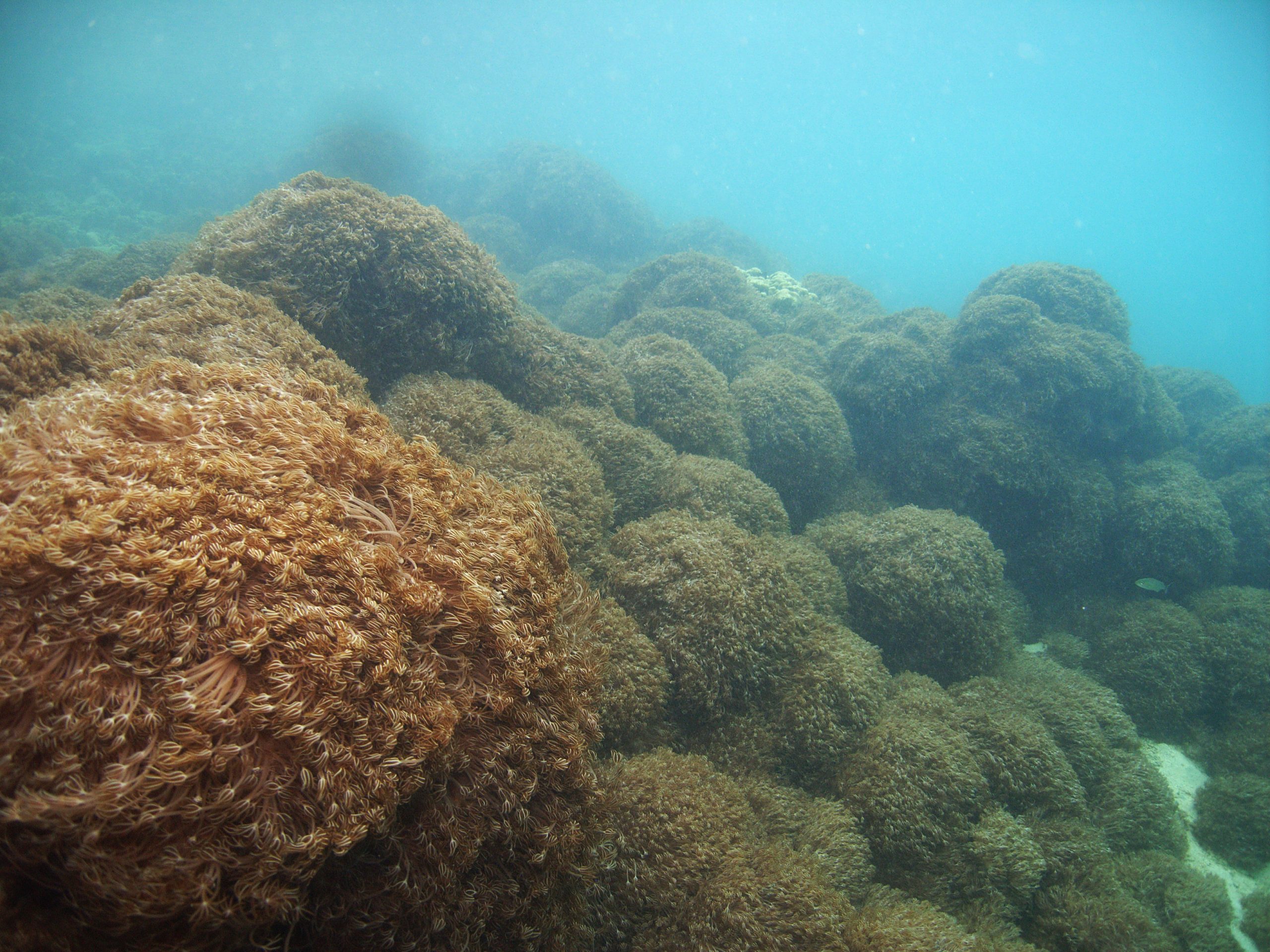
Invaded reef, year 2013
What can we do anyway?
Our best chance with Unomia is to study the soft coral in the lab under controlled conditions and to experiment with farming and extraction in an exceedingly small scale in the ocean. The aim will be to better understand the behavior of the Unomia in this new ecosystem.
Apart from that, we cannot yet see to do anything else. Sadly, this is what professor Carlton had warned all these years ago.
Suggestion
It’s logical to think that if everything moved freely and rapidly as if it were all the same piece of land, this would cause a terrible degradation in the world’s biodiversity. Already invasive species are the second cause of animal extinctions.
Regardless of the efforts made studying these events, we still can’t predict what will happen every time a species is introduced into a pristine environment. The future is uncertain!
Whatever happens at the end, we need to learn about this and create government programs that work to prevent these occurrences and to act in a timely manner. Before our politicians and governing agencies make those policies, they need to understand the economic value of the reefs and coastal ecosystems. Not all regions have the same economic value, but all have the same intrinsic value, perhaps a subject for another article.
Professor Carlton insists that the best advice for divers is that we need to wash our scuba equipment very well before we leave a dive site so we don’t inadvertently transport fauna/organisms elsewhere. We have always considered divers to be an ambassador for the ocean, so let’s include this topic as well in our conversations.
Thanks to Professor Carlton for letting me pick his brain and to Juan Pedro Ruiz-Allais for the talks about this subject to better understand the reach of the situation in Venezuela.
1 Rode and Lieberman 2004
2 Want to know more about Unomia is the New Name of Xenia elongate, visit this link.
3 Octocorallia is a class of Anthozoa comprising around 3,000 species of water-based organisms formed of colonial polyps with 8-fold symmetry. It includes the blue coral, soft corals, sea pens, and gorgonians within three orders: Alcyonacea, Helioporacea, and Pennatulacea.
4 If you want to know more about the economics of the reef, visit this link.
DIVE DEEPER
Bloomberg: A Killer Coral Is Smothering Reefs Off Venezuela’s Caribbean Coast By Camille Rodriguez Montilla. The highly invasive Unomia species is spreading quickly, raising worries it will stifle marine biodiversity.
Other stories by Carlos Lander:
- InDEPTH:The Future Of Food Is In The Sea
- InDEPTH: Andy Torbet: The Swiss Army Knife of the Diving Community
About the author
Carlos Lander is a father, a husband, and a diver. A student of economics, he’s a self-taught amateur archaeologist, programmer, and statistician. In his view, the amateur brings a unique mindset to the table and, paired with expertise from professionals, can discover advantages in the field. I studied economics at university. My website is Dive Immersion.


